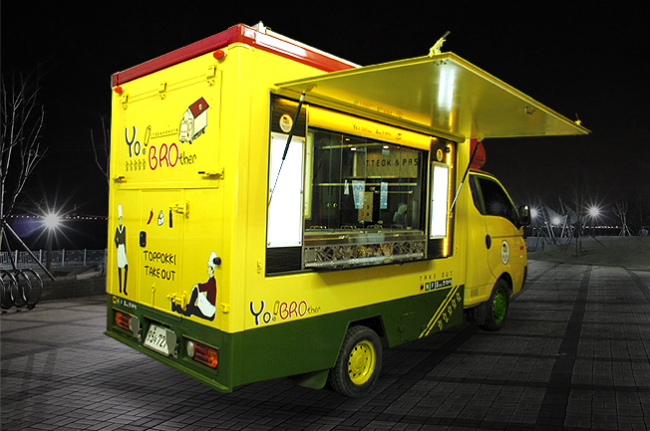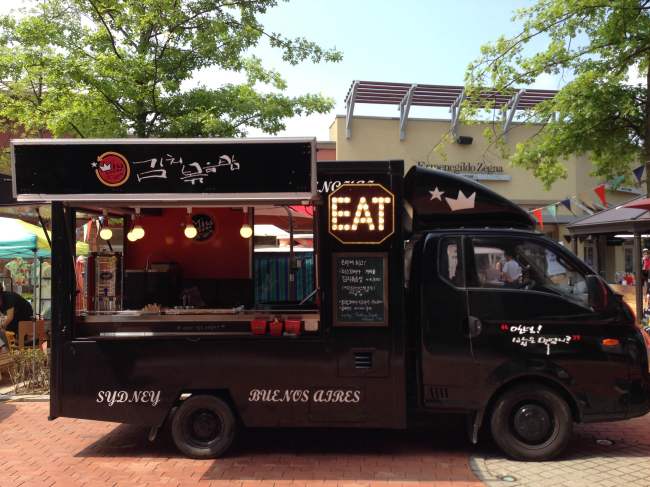Korea is famous the world over for its vibrant street food culture, with stalls, carts and booths selling time-tested delicacies at every turn. So it may come as a surprise to some that food trucks -- vehicles outfitted to accommodate cooking facilities -- were just legalized in Korea in August 2014 as a part of the deregulation efforts pushed by the Park Geun-hye administration.
Although food trucks were touted as a way to increase opportunities for young entrepreneurs who may not have the capital to rent shop space, that effect has yet to be seen because the “system to regulate food trucks is still in its infancy,” according to Bae Young-gi, who heads up the Korea Food Truck Cooperative and also runs Duriwon F&F, a food truck renovation company.
 |
(Duriwon F&F) |
The process of legalizing food trucks has been rough, particularly because of pushback from storeowners who fear the additional competition. But this opposition has produced an unexpected, yet welcome outcome: In order to appease surrounding businesses and increase competitiveness, many food trucks feature unusual and quirky offerings, or interesting themes to add personality to their menus.
The food trucks parked at the colorful “Food Truck Market” in the trendy Common Ground mall near Konkuk University, for example, offer Korean-Mexican fusion dishes, churros, hamburgers and onigiri (rice balls wrapped in laver). The trucks are decorated with catchy phrases like “For the burger/By the burger/Of the burger” or “It’s good enough to eat!”
Food Truck Factory, a truck renovation company that gained fame by designing food trucks featured on TV, offers trucks designed for selling Greek gyros, Mexican food or Philly cheesesteaks.
Yim Jin-young, who owns a food truck called “Miss Corea” that sells kimchi fried rice freshly cooked in an iron pot, said that when she was selling to high schoolers who were trying to grab a quick bite in between grueling after-school programs, she would use the slogan “Hey, have you eaten yet?”
“I’ve had students email me and tell me that those words gave them some comfort while they were struggling with the stress of competition,” she told The Korea Herald.
 |
Miss Corea food truck (Miss Corea) |
Yim also mentioned that the menu for a food truck had to be considered carefully not only for marketability, but also for practicality.
“You don’t want your menu to overlap with surrounding stores, but you don‘t want to make your food so unique and fancy that it’ll take long to prepare,” she said, noting that most food truck customers are looking for fast and easy options. “You’re also cooking in a truck, so you have to make sure that you’ll be able to fit everything you need into the vehicle.”
She said that since she sold kimchi fried rice, she was able to fulfill all her water supply needs with bottled water, but trucks with other menu offerings could face trickier situations when it comes to water or keeping their ingredients fresh.
Currently, there are fewer than 100 spots around the country that have been authorized for the operation of food trucks.
“The number’s growing,” Bae said. “Each regional government is responsible for allotting the spots, and some -- especially in Seoul and Gyeonggi Province -- are very open to expanding spots for food trucks. Other regions will have no choice but to benchmark the metropolitan areas.”
 |
Hand in Hand Burger food truck in Common Ground, Seoul. (Won Ho-jung/The Korea Herald) |
The Seoul Metropolitan Government made moves to that effect Tuesday, announcing that it will propose to expand areas open to food trucks to tourism zones such as Myeong-dong and Itaewon, as well as public cultural attractions such as art museums, pedestrian-only streets and traditional markets.
However, Bae says, it‘s important “not only to increase the quantity of spots,” but also viability. Food trucks may no longer be illegal, but that does not make them profitable, or even financially stable.
“Most of the places food trucks are permitted to operate are places with little foot traffic,” Bae said. “The people who operate food trucks don’t expect to make a lot of money, but they do expect to make enough to cover the cost they invested into buying a food truck and to make a living. But even that’s difficult.”
The problem is exacerbated by the fact that according to the current law, food trucks are not permitted to move out of the specific spot they have been assigned. Bae said that food trucks often “took the risk” of driving away “because they realized the spot the government gave them had no merit.”
There are some vendors who hesitate to seek registration because of this predicament.
“The reason I move around is because it’s difficult to break even if you stay in one spot,” said a 56-year-old vendor who sells sundae (blood sausages) out of the back of his truck in Gwanak-gu, Seoul. He asked not to be identified by name because he is currently operating illegally, without an official permit.
“I go to one spot on Monday, one spot on Tuesday, and so on. It took a long time for me to figure out which places are most profitable. I would have to shut down if I couldn’t do that.”
When asked why the members of his cooperative would take on the initial burden of financing a food truck, sometimes even going into debt, and trudging through the process of registration and sanitation education as well as the bidding process for an authorized spot, Bae said it was a matter of “mindset.”
“A lot of the people who are thinking of operating a food truck are in their late 20s and early 30s,” he said. “They have a different mindset. They want to pay taxes, to do their part as small businesses. They want to be recognized as legitimate businesses, even though they don’t have a building.”
“It’s important to remember that it has only been a short while since food trucks have become recognized,” Bae said. “It’s too early to say whether this policy will succeed or fail. I’m very hopeful that things will get better.”
By Won Ho-jung (
hjwon@heraldcorp.com)









![[Today’s K-pop] Blackpink’s Jennie, Lisa invited to Coachella as solo acts](http://res.heraldm.com/phpwas/restmb_idxmake.php?idx=644&simg=/content/image/2024/11/21/20241121050099_0.jpg)
